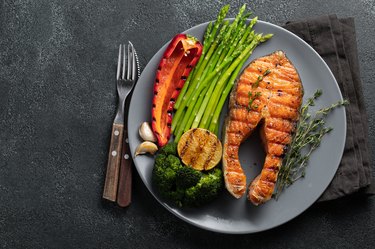
Now and then, most everyone has leftover fish to warm. The best way to reheat fish is the oven method, but you may also use a steamer to impart moisture. Instead of warming fish, you always have the option of chopping it to eat cold in a salad.
Tip
To reheat fish, put it in a rimmed pan in an oven preheated to 275 degrees Fahrenheit. Warm for 15 minutes, until the internal temperature reaches 125 to 130 F.
Video of the Day
Reheating Fish in Oven
LIVESTRONG.com interviewed Mascha Davis, MPH, RDN, founder of Nomadista Nutrition and author of the book Eat Your Vitamins, to get her perspective on reheating fish.
Video of the Day
Home cooks frequently ask about how to warm leftover salmon. "You can reheat salmon in the oven at a low temperature, such as 275 F, for about 15 minutes, until it reaches 125 to 130 F. Cover it loosely with foil. If you use too high of a temperature, the fish will become too dry. You can also reheat salmon in a steamer. This helps retain moisture," she says.
The oven and steamer methods can also be used to reheat cod and other fish varieties. "Just make sure you warm them slowly, and wrap or cover them with foil, if you use the oven. Any fish is prone to drying, especially the thinner fillets," Davis notes.
Read more: How to Cook Fish Without Oil
What about fried fish? Is this trickier to warm? "You can reheat fried fish in the oven with a little oil. Bake it for about 15 minutes at 350 F, and make sure it's cooked through before eating," she says.
More Reheating Advice for Fish
Reheating fish in a microwave, at work or at home, is possible, but not highly recommended. The appliance is likely to dry out the food, and release the fishy odor that is sometimes associated with seafood. To prevent these problems, the oven method is better.
However, for those who prefer to use the microwave, Davis provides these instructions. "The best way is to put it in the microwave for 20 seconds at a time and keep repeating until the fish is just right. To avoid drying, don't put the fish in the microwave for too long or use a high power."
If you want to eat salmon the day after you cook it, make sure your fish is high quality, Davis advises. "When shopping for salmon, look for wild-caught, certified-sustainable salmon with the Marine Stewardship Council's blue fish label. Heat it through again before eating. Keep in mind that you can also enjoy salmon cold in salads," she adds.
Fish-Cooking Safety Tips
To thaw fish, put it in the refrigerator overnight, advises the Food and Drug Administration (FDA). When you don't have time for the overnight method, put the fish in a sealed plastic bag, and immerse it in cold water until thawed.
If you choose to thaw frozen fish in the microwave, cook it immediately afterward. Some areas of the fish may begin to cook, and keeping partially-cooked food to use later poses the danger of a foodborne illness, cautions the USDA Food Safety and Inspection Service.
FoodSafety.gov advocates cooking fish with fins to 145 F. At this point, the flesh should look opaque, and flake easily with a fork.
Once cooked, don't leave fish at room temperature for more than two hours. If the temperature is warmer than 90 F, don't leave it unrefrigerated for more than one hour. The bacteria that cause foodborne illness can grow at temperatures between 40 and 140 F. According to the FDA, if you refrigerate cooked fish properly, it should stay good for three to four days.
- Nomadista Nutrition: "Homepage"
- Simon & Schuster: "Eat Your Vitamins"
- Food and Drug Administration: "Selecting and Serving Fresh and Frozen Seafood Safely"
- USDA Food Safety and Inspection Service: "Cooking Safely in the Microwave Oven"
- FoodSafety.gov: "Safe Minimum Cooking Temperatures Charts"
- Food and Drug Administration: "Refrigerator and Freezer Storage Chart"
- Nomadista Nutrition: "Mascha Davis, MPH, RDN: About Me"